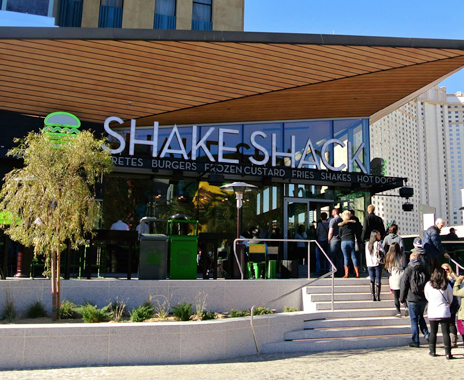After outperforming Wall Street the past few years, the stock prices of restaurant companies with quick-service concepts finished a bit worse than the overall market in 2014.
Slightly more than half of limited-service dining companies’ stocks were bested by the Standard & Poor’s 500 index last year. A dozen companies, including quick-service giants McDonald’s and Yum! Brands, saw their equity prices decline during the period. The S&P 500 gained 11.4 percent, but its restaurant sector index rose just 4.3 percent.
The results were not completely unexpected after several years of gains, says Efraim Levy, restaurant analyst at S&P Capital IQ, a New York–based research and data provider that focuses on the capital markets.
“After several years of out-performance, perhaps there was some catch-up here,” he says. Over the past five years, restaurant stocks were up 17.1 percent versus 13 percent for the S&P 500, and “sometimes you need to take a breather in overall fundamentals.”
Problems faced by both McDonald’s and Yum, including supplier woes in China, have weighed on those companies’ shares, which are part of the S&P restaurant index, Levy says. McDonald’s also has watched its comparable American store sales slump.
Some other analysts believe that many restaurant shares are fully valued, keeping a ceiling on those equities. The healthy valuations are one reason a number of companies launched their initial public offerings (IPOs) of stock last year.
Four limited-service restaurant companies—quick-service veterans El Pollo Loco and Papa Murphy’s, along with fast casuals Zoës Kitchen and Habit Restaurants—launched IPOs during the year. All ended 2014 with share values higher than their opening prices.
Already this year, one anticipated restaurant IPO is ready to hit the market. Shake Shack, the New York–based fast-casual burger chain created a decade ago by restaurateur Danny Meyer, could raise up to $92 million when it goes public, possibly on Friday.
According to documents filed with the U.S. Securities and Exchange Commission, Shake Shack, which has 31 units in six states and Washington, D.C., as well as more than two dozen internationally, plans to sell 5.8 million shares for up to $16 each. There’s been significant buzz on Wall Street about the Shake Shack offering, in part because many equities industry professionals are fans of the restaurant company and see that the annual unit volumes of its Manhattan stores are $7.4 million.
But some observers warn against over-optimism and question Shake Shack’s growth potential, including the company’s projected plan to open 10 new domestic, company-operated restaurants each year for the foreseeable future, eventually reaching 450 units.
“People notice there are long lines outside the doors of its New York restaurants even in the cold weather, but it’s a different demographic there than around the country,” says Francis Gaskins, founder of research firm IPOdesktop.com in Marina del Ray, California. “It’s not easy to find the demographic nationally willing to pay for high-priced burgers.”
Gaskins adds that another challenge for Shake Shack is competition from other better-burger chains.
Although all of last year’s restaurant IPOs finished the year above their offering prices, the same can’t be said for 2013’s offerings, Potbelly Sandwich Works and Noodles & Co., which ended 2014 as the worst and third-worst performing stocks, respectively. Gaskins suggests weak results and slower-than-expected growth were to blame.
The best quick-service stock performer in 2014 was Good Times Restaurants Inc. The Colorado company’s shares jumped 176.2 percent thanks to strong same-store sales at its 37 units.
“We were up double-digit comps last year on top of double-digit comps in 2013, which is sort of unique for a brand that’s around 20-some years old,” says company president and chief executive Boyd Hoback. “That had a big impact on our margins and cash flow.”
Good Times is also in a joint venture with North Carolina–based full-service concept Bad Daddy’s Burger Bar, which it is helping to open both corporate and franchised locations.
Although the company is not profitable due to heavy investing, the Good Times Burgers & Frozen Custard restaurants are in the black on an operating basis. Hoback credits a high-quality menu, including fresh-cut fries and hand-breaded chicken tenders, for this.
“We’ve also been introducing strong taste profiles, such as the vegetarian black bean burger and our Hatch, New Mexico, green chile as a platform for breakfast,” he says, adding that the chain likely will expand next year beyond its two-state region.
The runner-up best performer last year was Oakville, Ontario–based Restaurant Brands International, which gained 70.8 percent. Formerly Burger King Worldwide, the stock rose on strong financial results and the $11 billion acquisition of Tim Hortons.
Rounding out the top five stock performers were Jack in the Box (up 59.9 percent), Nathan’s Famous (58.7 percent), and Popeyes Louisiana Kitchen, formerly AFC Enterprises (46.2 percent).
At the other end of the spectrum, Potbelly (down 47 percent) was followed by Fuddrucker’s owner Luby’s (down 41.1 percent), Noodles & Co. (down 26.6 percent), Steak ‘n Shake owner Biglari Holdings (down 15.1 percent), and Pizza Inn (down 11.9 percent).
Shares of big name companies Starbucks, Wendy’s, and Panera Bread were flat.

